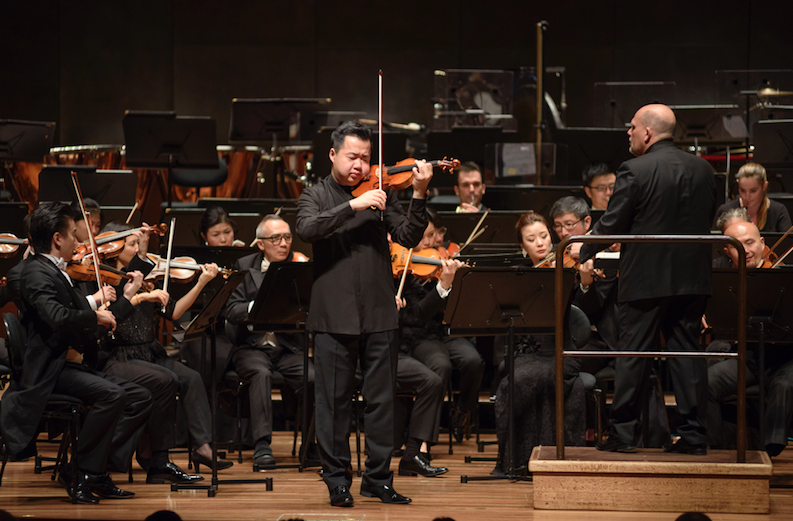There’s nothing quite like the late-Romantic splendour of the finale to Mahler’s First Symphony to fire up a crowd, and here the Hong Kong Philharmonic Orchestra, making their Australian debut under Chief Conductor Jaap van Zweden, demonstrated the flair and imagination that has earned the first two parts of their excellent recent Naxos Ring Cycle a slew of international plaudits. Nicely detailed percussion, attentive phrasing from the strings and fine, enthusiastic brass kicked musical arse, as they say, while the reflective central section was equally distinguished with notable contributions from concertmaster Jing Wang, who with his violinist colleague Leung Kin-fung were an impressive double act all night.
Elsewhere in this routinely programmed concert, matters were distinctly variable, and frustratingly so at times, but let’s begin at the beginning. Fung Lam is the orchestra’s Director of Orchestral Planning and the first Hong Kong composer ever to be commissioned by the BBC. His new orchestral work Quintessence attempts to encapsulate Buddhist ideas of attainment and of striving towards one’s highest goals.
An episodic work, it meanders its way home with some attractive stop-offs along the way. The violin section pass a theme from one solo instrument to the next, there’s an urban nocturne with mournful brass and tolling bells, and there’s plenty of orchestral colour on percussion, harp and shimmering strings. Whether this adds up to anything tangible, however, is uncertain, though perhaps that isn’t the point. The orchestra under Zweden’s disciplined baton gave it every chance to make its mark and it certainly didn’t outstay its welcome.
 Ning Feng and Jaap van Zweden. Photo © Hong Kong Philharmonic Orchestra
Ning Feng and Jaap van Zweden. Photo © Hong Kong Philharmonic Orchestra
The HKP’s choice of soloist for this five-city tour was a judicious one. Chinese violinist Ning Feng has visited Australia before, and last year impressed Perth audiences with some impressive Paganini. You do have to question, though, why you would pick Mozart for an orchestral debut tour? The SOH Concert Hall acoustic can suck the life out of a sizeable band playing down to accompany a soloist in this repertoire, and the orchestra, though admirably sensitive to Ning as front man, could barely be made out at times. Zweden’s choice of tempi was admirable, and there was certainly nothing audibly wrong with the orchestra, but it was hardly what you’d call a showcase.
On the plus side, Ning was a fine soloist, his bright, substantial tone stood out clear as a bell, while his sensible pacing made for a cleanly realised reading. He was at his finest in the singing Andante cantabile, his excellent legato smooth as butter and his sense of communion intense. Rich at the bottom, and with some charmingly executed suspensions at the top, this was fine Mozart as you would might expect to hear it played. One couldn’t help comparing it though with the revelatory Academy of St Martin in the Fields’ performances of the same work two weeks ago. The Hong Kongers offered Melbourne audiences Bartók’s Second, probably a better choice.
Finally then, the Mahler, which finished so brilliantly. The First Symphony is a great orchestral vehicle, a chance for all sections to shine, but also a test of concentration, stamina and discipline. It became clear early on that Zweden is good on the third of those, carfully controlling tempi and phrasing, The orchestra, however, is clearly at its best when going full throttle, so the lengthy dawn-inspired opening of the first movement was problematic. Woodwind were consistently too loud, with little inner imagination to lift the birdsong beyond a simple series of notes on oboe and clarinet. The gear-change into Mahler’s big walking tune felt matter-of-fact rather than breath-taking, and the big build at the end of the movement lacked sufficiently detailed dynamics (though the climax still packed a reasonable punch).
The rustic Ländler second movement had plenty of Viennese schwung, though there were some internal balance issues at times. Zweden generated an intriguingly Wagnerian occasional sense of menace, as if a storm might be brewing just beyond the horizon. A nicely original touch. The famous ‘Frère Jacques’ funeral march started well on low strings and doleful timpani, but the clarinet and oboe pick ups were undistinguished and the ‘party music’ interruptions felt neither fish nor fowl. The violin duet, however, in the central section was first rate.
The aforementioned excellent finale was followed by a feel-good encore, Wagner’s Ride of the Valkyries, in what by now must be a bit of an orchestral signature tune. Given that Australians can hear first-rate, and I dare say better Mahler and Mozart playing care of their local State symphony orchestras, it might have been wiser for the Hong Kongers to play to their known strengths. Next time, perhaps.











Comments
Log in to join the conversation.